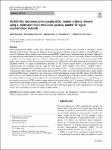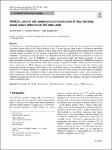Search
Author
- Andreas, Theissler (1)
- Dominik, Raab (1)
- Md Shafayet, Hossain (1)
- Muhammad E. H., Chowdhury (1)
- next >
Subject
Date issued
Has File(s)
- true (2)
Search Results
Electroencephalogram (EEG) signals suffer substantially from motion artifacts when recorded in ambulatory settings utilizing wearable sensors. Because the diagnosis of many neurological diseases is heavily reliant on clean EEG data, it is critical to eliminate motion artifacts from motion-corrupted EEG signals using reliable and robust algorithms. Although a few deep learning-based models have been proposed for the removal of ocular, muscle, and cardiac artifacts from EEG data to the best of our knowledge, there is no attempt has been made in removing motion artifacts from motion-corrupted EEG signals: In this paper, a novel 1D convolutional neural network (CNN) called multi-layer multi-resolution spatially pooled (MLMRS) network for signal reconstruction is proposed for EEG motion ... |
In clinical practice, algorithmic predictions may seriously jeopardise patients’ health and thus are required to be validated by medical experts before a final clinical decision is met. Towards that aim, there is need to incorporate explainable artificial intelligence techniques into medical research. In the specific field of epileptic seizure detection there are several machine learning algorithms but less methods on explaining them in an interpretable way. Therefore, we introduce XAI4EEG: an application-aware approach for an explainable and hybrid deep learning-based detection of seizures in multivariate EEG time series. In XAI4EEG, we combine deep learning models and domain knowledge on seizure detection, namely (a) frequency bands, (b) location of EEG leads and (c) temporal char... |


